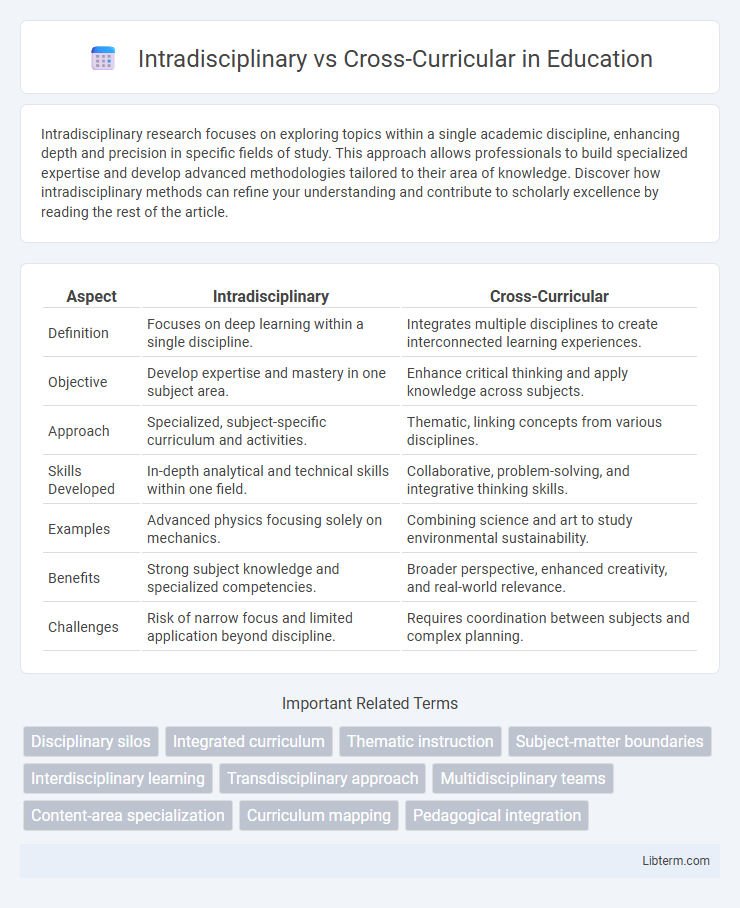Intradisciplinary research focuses on exploring topics within a single academic discipline, enhancing depth and precision in specific fields of study. This approach allows professionals to build specialized expertise and develop advanced methodologies tailored to their area of knowledge. Discover how intradisciplinary methods can refine your understanding and contribute to scholarly excellence by reading the rest of the article.
Table of Comparison
| Aspect | Intradisciplinary | Cross-Curricular |
|---|---|---|
| Definition | Focuses on deep learning within a single discipline. | Integrates multiple disciplines to create interconnected learning experiences. |
| Objective | Develop expertise and mastery in one subject area. | Enhance critical thinking and apply knowledge across subjects. |
| Approach | Specialized, subject-specific curriculum and activities. | Thematic, linking concepts from various disciplines. |
| Skills Developed | In-depth analytical and technical skills within one field. | Collaborative, problem-solving, and integrative thinking skills. |
| Examples | Advanced physics focusing solely on mechanics. | Combining science and art to study environmental sustainability. |
| Benefits | Strong subject knowledge and specialized competencies. | Broader perspective, enhanced creativity, and real-world relevance. |
| Challenges | Risk of narrow focus and limited application beyond discipline. | Requires coordination between subjects and complex planning. |
Understanding Intradisciplinary Learning
Intradisciplinary learning emphasizes deepening knowledge and skills within a single discipline, fostering specialized expertise and critical thinking directly related to that field. This approach encourages students to explore complex concepts, methodologies, and principles unique to one subject area, enhancing mastery and subject coherence. Intradisciplinary learning contrasts with cross-curricular strategies by maintaining disciplinary boundaries rather than integrating multiple subjects.
Defining Cross-Curricular Approaches
Cross-curricular approaches integrate content, skills, and standards from multiple subject areas to create cohesive learning experiences that promote critical thinking and problem-solving across disciplines. Unlike intradisciplinary methods that deepen understanding within a single discipline, cross-curricular strategies foster connections and real-world applications by blending diverse academic fields. This approach enhances student engagement and knowledge retention by contextualizing learning within broader themes or projects.
Key Differences Between Intradisciplinary and Cross-Curricular Methods
Intradisciplinary methods focus on deepening students' understanding within a single discipline by exploring concepts, skills, and content exclusively related to that subject. Cross-curricular methods integrate multiple disciplines, encouraging connections and applications across different subject areas to enhance critical thinking and real-world problem solving. The key difference lies in intradisciplinary approaches maintaining subject-specific boundaries, while cross-curricular approaches deliberately blend disciplines to create interdisciplinary learning experiences.
Benefits of Intradisciplinary Education
Intradisciplinary education enhances deep expertise by concentrating learning within a single discipline, fostering mastery and specialized critical thinking skills. It allows students to build a strong foundation, promoting analytical rigor and nuanced understanding of complex concepts specific to that field. This focused approach also supports advanced problem-solving abilities by encouraging in-depth exploration and synthesis of specialized knowledge.
Advantages of Cross-Curricular Teaching
Cross-curricular teaching enhances student engagement by integrating multiple subjects, fostering critical thinking and real-world problem-solving skills. It promotes deeper understanding through connections between disciplines, encouraging collaboration and creativity. This approach prepares students for complex challenges by bridging knowledge gaps and developing versatile learning strategies.
Challenges in Implementing Intradisciplinary Strategies
Intradisciplinary strategies face challenges such as limited collaboration opportunities within rigid subject boundaries and difficulties in designing cohesive lesson plans that deeply integrate specific disciplinary concepts. Educators often struggle with balancing content depth and maintaining student engagement without the diverse perspectives found in cross-curricular approaches. Resource constraints and professional development gaps further hinder effective implementation of intradisciplinary teaching methods in schools.
Overcoming Barriers in Cross-Curricular Integration
Overcoming barriers in cross-curricular integration involves addressing challenges such as differing departmental goals, varied teaching methodologies, and assessment standards. Effective communication and collaborative planning among educators across disciplines foster a cohesive learning environment, enabling the seamless blending of content and skills. Implementing shared objectives and interdisciplinary projects supports students' deeper understanding and real-world application of knowledge, bridging gaps between disparate subject areas.
Real-World Examples of Intradisciplinary Learning
Intradisciplinary learning emphasizes deep exploration within a single discipline, helping students master specific skills such as scientific experimentation in biology or mathematical problem-solving. Real-world examples include a chemistry lab project analyzing water quality, where students apply chemistry concepts exclusively to investigate environmental factors. This focused approach contrasts with cross-curricular learning, which integrates multiple disciplines to address broader topics like climate change or urban planning.
Successful Cross-Curricular Project Models
Successful cross-curricular project models integrate multiple academic disciplines, enabling students to apply knowledge from different subjects to real-world problems, enhancing critical thinking and collaboration skills. These projects often involve coordinated planning among teachers to create cohesive learning experiences that connect concepts in a meaningful context, such as combining science, math, and language arts to investigate environmental issues. Compared to intradisciplinary approaches that deepen expertise within a single subject, cross-curricular models foster broader competencies by blending diverse perspectives and skill sets.
Choosing the Right Approach: Factors to Consider
Choosing between intradisciplinary and cross-curricular approaches depends on the learning objectives and subject complexity. Intradisciplinary methods strengthen deep expertise within one discipline, ideal for specialized knowledge acquisition. Cross-curricular strategies promote critical thinking and real-world application by integrating concepts from multiple subjects, enhancing student engagement and problem-solving skills.
Intradisciplinary Infographic

 libterm.com
libterm.com